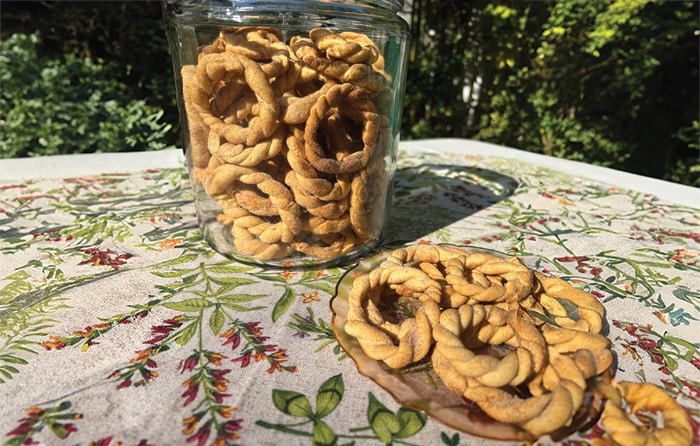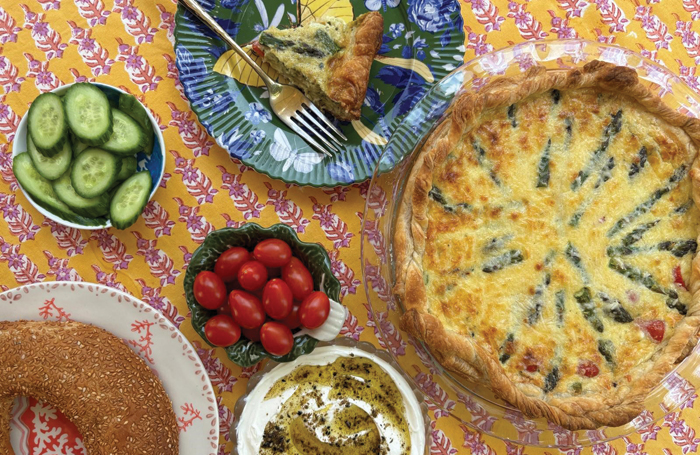Biscochos— Sweet Rings of Love
My childhood memories are filled with cookies. Even more than they love cakes, Moroccans love their cookies.

Ask an American child “What is your favorite cookie?”
It’s most likely that they will answer, a chocolate chip cookie. But for me, the question of my favorite cookie is more complex.
My childhood memories are filled with cookies. Even more than they love cakes, Moroccans love their cookies. The Moroccan kitchen is filled with so many varieties—some festive for holidays and life cycle celebrations, others for every day dunking in coffee or mint tea. My mother was an expert baker and turned out beautiful cookies on a regular basis, including tortitas (galette), mazapanes, griba and almond cigars. Some of her fancy cookies featured marzipan or nuts, others were more simple variations of flour and sugar, flavored with orange blossom water or fennel seeds.
In the 1970s, as immigrants to the United States, my family enjoyed trying all the different varieties of store-bought cookies. We loved those iconic pink and white frosted Mother’s Circus Animal Cookies, Nutter Butters, and, of course, Oreo style sandwich cookies.
We loved Nilla wafers, especially dipped in milk. My favorite after-school treat was to fill a cup with the wafers and pour milk over them, then eat the sweet mush with a spoon.
While I don’t indulge in these cookies nowadays, passing by their bright packaging in the grocery aisle still gives me a cozy, loving feeling.
Recently, my brother Moise sent my brother Salomon and me a photo of Stella D’oro S-shaped breakfast treats that he had snapped at the market. In our group chat, we joyously reminisced about how good they were and how much we loved dipping these almond-flavored cookies into our hot mint tea. They stand out as my family’s most nostalgic cookie of the 1970s. We always had a package in the kitchen cabinet. Now that I think of it, we probably loved them because that almond flavor was so Moroccan and was the closest to our mother’s home-baked cookies. That makes me smile.
As my brothers and I married, my parents were blessed with grandchildren. Usually my mother would have freshly baked cookies for their visits, but she would also stock up on Pepperidge Farms Milano cookies. To this day, if you ask any of the grandchildren what is their favorite store-bought cookie they will answer, Milanos!
One of the sweetest memories of when I started dating Neil are the Shabbat afternoons spent with him at the home of his honorary aunt Sylvia Aboulafia. Everyone would gather at the kitchen table and we would be served hot coffee. Sylvia would pull out the big Yuban coffee can filled with her freshly baked biscochos. Biscochos are a favorite of the Ladino kitchen. They are a crunchy, slightly sweet, ring cookie that are dipped in cinnamon sugar or sesame seeds before baking. Neil tells me that it was always a platter piled with biscochos that welcomed family and friends for a “vijita”, an extended visit on Shabbat afternoons throughout the Rhodesli community living around Liemert Park and Crenshaw Village in the ’60s of his youth.
Just as the Sephardic Jews were dispersed throughout the Middle East and North Africa, the recipe for biscochos travelled with them. Our dear friend Esther Avrahamy is of Aleppo Syrian and Turkish descent via Cuba, Brooklyn and Miami. Her family also has a love for biscochos, which are often called a sweet ka’ak by Syrian Jews. Whenever her mother “abuela” Miriam visits from Miami, she lovingly bakes a huge batch for her grandchildren and their appreciative friends.
Last week, I had the privilege of spending the day with Esther and Jazmin Duek. We baked dozens of biscochos and many other sweets for the upcoming wedding of Esther’s daughter Miriam (Sephardic tradition is to name in honor of grandparents). The day before the wedding, we will celebrate a Bano de Novia, which is basically a Mikvah party. After the ritual purification of immersing in the Mikvah, the bride, her mother and future mother-in-law will all light candles and recite blessings. These candles will be extinguished and the bride will save these candles to light future Shabbat candles in her new home.
The tradition is to have 52 cookies tied with a thread or a ribbon. The significance of 52 is twice the numerical value of Hashem, the name of G-d. We also baked a large Magen David from the same cookie dough. Esther and the groom’s mother will each give a blessing for the new couple and break the Magen David over Miriam’s head. This ceremony reminds us of the destruction of the Beit Hamikdash, the Holy Temple. And also to protect the bride from the evil eye. G-d forbid, if the bride is subject to an evil eye, the moment of breaking the Magen David will cause the evil eye to disappear. The bracha of Borei Mi’ne Me’zonot is recited and all the guests indulge in a biscocho.
What is the power of a cookie to create such a tradition? What is it about a cookie that unlocks those special childhood memories? And what is it about a cookie that makes one feel love, friendship, joy?
I don’t think it’s about the actual cookie. It is about the history, the experience. It’s about someone lovingly serving you a cookie and giving you the sense of being taken care of.
I don’t think it’s about the actual cookie. It is about the history, the experience. It’s about someone lovingly serving you a cookie and giving you the sense of being taken care of.
—Rachel
This is the perfect recipe for yummy cookies to keep in your cookie jar. Light, subtle, sweet and deliciously crispy.
Perfect to serve to your loved ones, to make your own special memories!
—Sharon
Biscochos Recipe
4 eggs
1 cup sugar
2/3 cup oil
2 teaspoon vanilla
6-7 cups cake flour
2 teaspoons baking powder
2 teaspoons vanilla essence
Pinch of salt
1/4 teaspoon baking soda
Topping
1/4 cup fine sugar
2 teaspoons cinnamon
Preheat oven to 350°F.
In a stand mixer, combine all the ingredients until the dough comes together and forms a ball.
Place dough on the counter and gently knead for about a minute, until dough is smooth and comes together.
Roll all the dough into walnut-sized balls.
Roll into a thin strand, then double the strand and twist into a rope.
Close into a ring, then dip into cinnamon sugar.
Place cookies on parchment lined baking sheets and bake for about 20 minutes, until firm and golden brown.
Remove cookies from the oven and allow to cool.
Lower oven temperature to 200°F.
Biscochar (crisp) the cookies by placing bracelets on a baking sheet and leave in the oven for one hour.
Transfer to a wire rack and allow to cool.
Store in an airtight container.
Rachel Sheff and Sharon Gomperts have been friends since high school. They love cooking and sharing recipes. They have collaborated on Sephardic Educational Center projects and community cooking classes. Follow them on Instagram @sephardicspicegirls and on Facebook at Sephardic Spice SEC Food.






